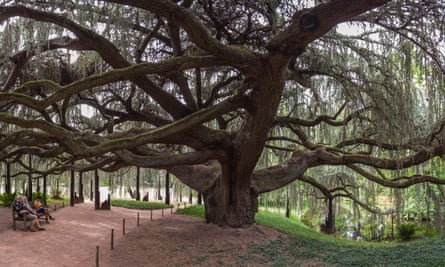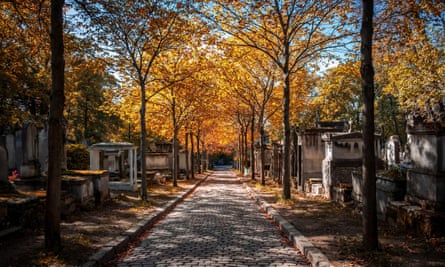Jardin du Luxembourg
Coming from New England, which is famous for its fall colours, I was disillusioned by the sheer multitude of brown, crumpled horse-chestnut leaves on display in Paris in autumn. So I began my quest for hints of gold, amber, russet and scarlet and have been richly rewarded.
The majority of gardens in Paris have two planting periods; the Luxembourg garden in the sixth arrondissement has three, giving it year-round interest. The cascading urns and autumn chrysanthemum displays would certainly have pleased Marie de’ Medici, who created this garden in the early 17th century. While its proportions have changed over the years, it remains a fabulous oasis in the centre of town. More than 600 espaliered fruit trees grow in the southern corner, next to the oldest beekeeping school in Paris.
Two of my favourite spots to read or have a picnic are next to the ornate Medici fountain, or on a bench along the shaded, curving pathways which skirt the garden. I also love the golden ginkgo tree which illuminates the Boulevard Saint-Michel.
Rue de Médicis/Rue de Vaugirard 75006, parisjetaime.com
Parc Clichy-Batignolles – Martin Luther King

There are many good reasons to venture north to the Batignolles district: the hip cafes and restaurants around Place du Dr Félix Lobligeois, the farmers’ market and the charming Square des Batignolles, where locals gather to play pétanque and feed the ducks. But the 17th arrondissement holds another surprise – the newly completed Martin Luther King park and the Paris Courthouse by Renzo Piano. Begun in 2004, this landmark composition was created on the site of a sprawling freight station. Its 10.8 hectares (27 acres) harmoniously incorporate the four seasons with water features and various sporting facilities. As the Japanese cherries don their fall colours, the extensive planting of billowy grasses and flaming ash and oak trees comes alive, alongside two community gardens and a large orchard.
147 rue Cardinet, 75017, parisjetaime.com
Albert Kahn Museum and Garden

The graceful Albert Kahn garden in the western suburb of Boulogne-Billancourt once served as a backdrop for the promotion of world peace. Kahn’s childhood experience of war made him a fervent pacifist. The banker and philanthropist believed that the underlying cause of war was a lack of mutual understanding and appreciation of other cultures. He built up a vast photographic and cinematographic collection, the Archives de la Planète, which is now on display in the museum. In his landscaped garden, he realised his vision of global harmony with beautiful displays of plants from different countries planted alongside each other. Today narrow paths wind through forests, wildflower meadows, past a conservatory and through two Japanese gardens with traditional and contemporary features. The sculptural layering and transparency pruning of the maple and cherry trees may even transport you to Kyoto. I strongly encourage any visitor to walk the garden twice – without a map the first time, just observing and enjoying. Every second Tuesday of the month the gardens are illuminated and stay open until 10pm.
14 rue du Port, 92100. From October to March, the museum and garden are open from Tuesdays to Sundays 11am-6pm, €8 adult, free for under-26s. On the first Sunday of each month, entry is free. albert-kahn.hauts-de-seine.fr/
Parc Floral de Paris

On the edge of the Bois de Vincennes, the Parc Floral botanical garden is one of four sites that make up the Botanical Garden of Paris. Created in 1969 as an open-air museum, it embodies “flower power”. The central pond is rimmed with exuberant seasonal planting, while the Four Seasons garden overflows with asters, salvias and Japanese anemones. Dogwoods, maples and hydrangeas flourish in the dappled shade of tall pines, but in autumn it is the dahlia beds which steal the show, and my heart. More than 400 varieties are on display, with new and centuries-old ones participating in the international dahlia competition which has run here for 30 years. From here it’s a short walk to the Chateau de Vincennes.
€2.50 from June to September, free the rest of the year. Route du Champs de Manœuvre 75012, visitparisregion.com
Arboretum de la Vallée-aux-Loups

Well worth the train ride on the RER B Line to Robinson Station, this 18th-century display garden was bought, preserved and opened to the public in 1994. The collections boast 165 types of tree, with many rare and mature species including magnificent Japanese maples, oaks, sweet gums and many shrub varieties with variegated foliage. I particularly connect to my own roots in the central section, which hosts many American trees and shrubs with flamboyant fall colours. A remarkable bonsai collection in the greenhouses closes early, at 4pm.
Across the street is Chateaubriand’s home and gardens, where he lived while writing Mémoires d’Outre-Tombe (Memories from Beyond the Grave).
Free, open year-round, 102 rue de Chateaubriand 92290, visitparisregion.com
Cemeteries

For autumnal bliss and an escape from the crowds, the cemeteries of Paris are ideal. All Saints’ Day is an important holiday here, and many of the tombs are decorated in the latter part of October. While Père Lachaise is well known for its famous occupants, it is not the only cemetery filled with peaceful, tree-lined avenues. Passy cemetery in the 16th arrondissement faces Place du Trocadéro and is the final resting place of Manet and Debussy. Montparnasse cemetery in the 14th has the graves of the artistic and intellectual elite of the Rive Gauche, while Montmartre can claim two cemeteries, each with their own charms and celebrities.
parisjetaime.com
Vineyards
Nothing says autumn beauty better than the bright yellow, orange and russet leaves of vines and their plump clusters of grapes. The largest global trading centre for wine was on the Seine in the 12th arrondissement during the 19th century, and grapes were grown in and around Paris until the 1960s. Fortunately this savoir-faire is being reintroduced in over a dozen locations. Today, 400 vines are growing in the Parc de Bercy. Meanwhile in Montmartre, the construction of a car park on its blissful hillside was prevented by the planting of grapevines in 1933 – the neighbourhood will celebrate its harvest festival from 11-15 October. A vineyard can also be seen in the 15th at Parc George Brassens, where the southern hillside is ringed with pinot noir vines and beehives. Cheers! angloinfo.com
Urban forests

The two forests that fringe the outskirts of the city are perfect for a serene escape. To the east is the Bois de Vincennes, and to the west the Bois de Boulogne; both are accessible by bus and metro. Created in the 19th century, they offer miles of footpaths, lakes surrounded by colourful trees with rowing boats to hire, and botanical gardens. The Bois de Vincennes also has a small arboretum and the mystical Jardin d’Agronomie Tropicale René-Dumont (Garden of Tropical Agronomy), where the 1907 Colonial Exhibition was held and plants were tested and propagated from and for the French colonies.
parisjetaime.com
Amy Kupec-Larue has lived in Paris since 1989 and runs bilingual botanical tours of gardens in Paris and elsewhere in France for individuals and groups: gardenguideparis.com
 Top Naija News: Nigerian News, Breaking News Nigeria and World News Top Naija News is a daily news publication in Nigeria, delivering the latest breaking news in Nigeria and around the world.
Top Naija News: Nigerian News, Breaking News Nigeria and World News Top Naija News is a daily news publication in Nigeria, delivering the latest breaking news in Nigeria and around the world.



